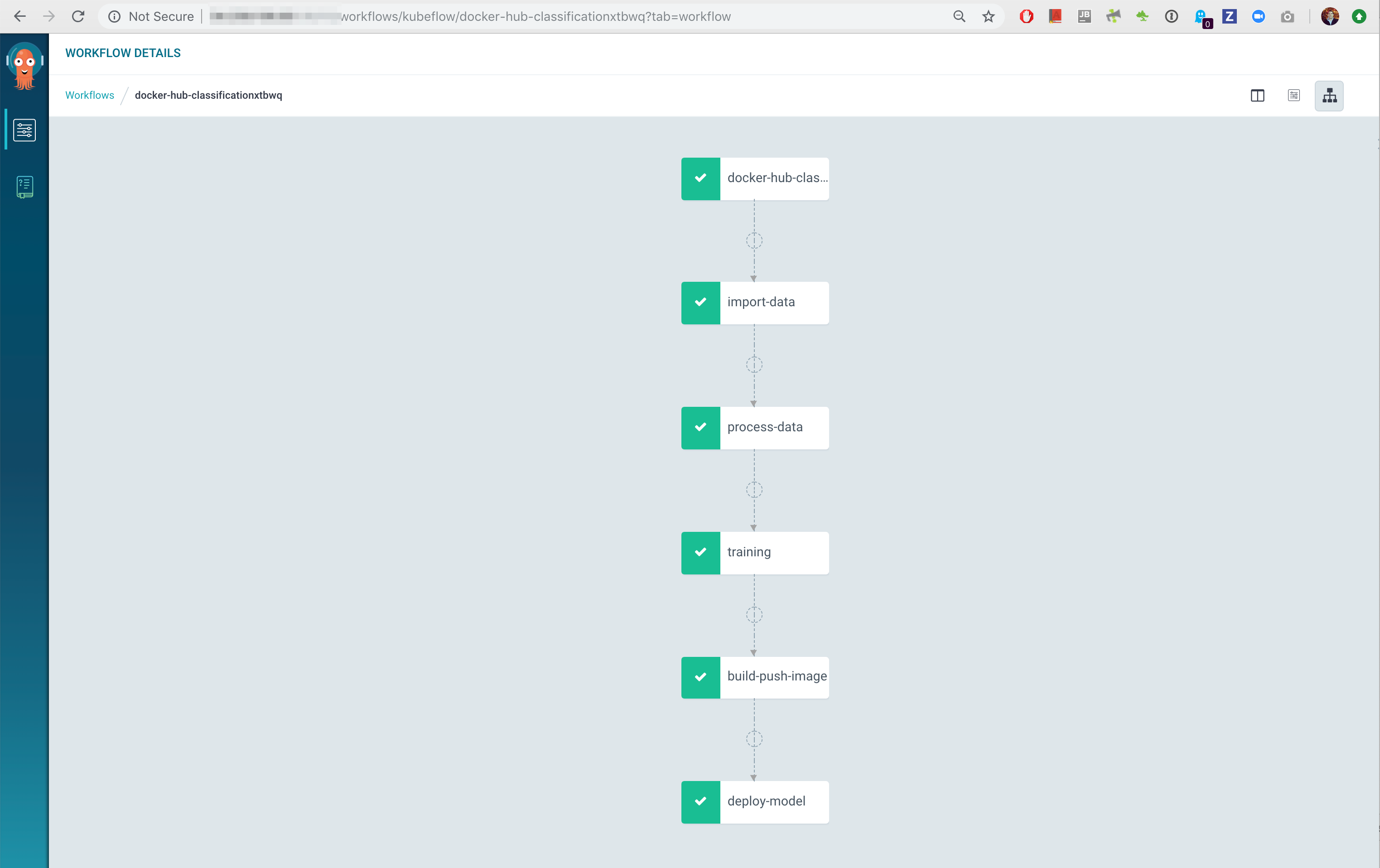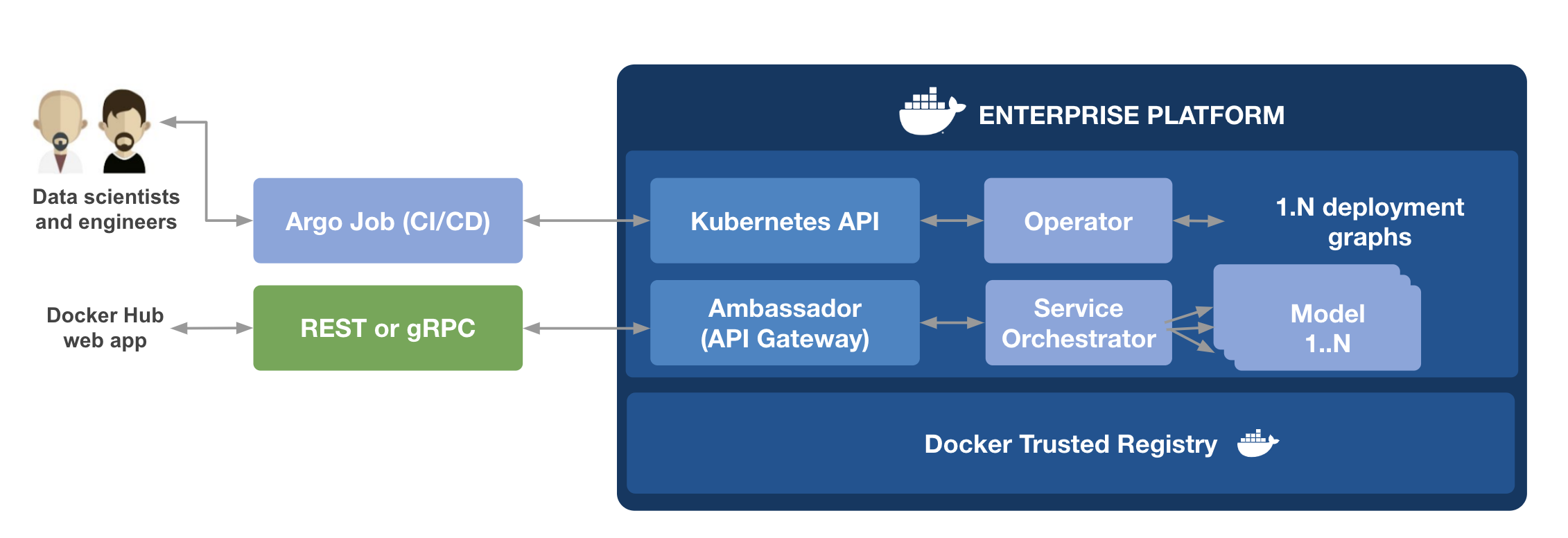This project is simple example of an automated end-to-end machine learning pipeline using Docker Desktop and Kubeflow.
- Docker Desktop for Mac or Windows.
- ksonnet version 0.11.0 or later.
- Argo
1. Build the base image used in the Argo workflow
$ git clone https://github.com/dockersamples/docker-hub-ml-project
$ cd docker-hub-ml-project
$ cd base && make build; cd ..
2. Install Kubeflow
$ export BASE_PATH=$(pwd)
$ export KUBEFLOW_TAG=master
$ curl https://raw.githubusercontent.com/kubeflow/kubeflow/master/scripts/download.sh | bash
$ ${BASE_PATH}/scripts/kfctl.sh init ks_app --platform docker-for-desktop
$ cd ks_app
$ ../scripts/kfctl.sh generate k8s
$ ../scripts/kfctl.sh apply k8s
Ok, now let's make sure we have everything up and running.
# switch to the kubeflow namespace
$ kubectl config set-context docker-for-desktop --namespace=kubeflow
$ kubectl get pods
(⎈ |docker-for-desktop:kubeflow) ~/d/r/m/p/d/2/d/d/ks_app$ kgp 16:58:17 ⎇ master
NAME READY STATUS RESTARTS AGE
ambassador-677dd9d8f4-hmwc7 1/1 Running 0 4m
ambassador-677dd9d8f4-jkmb6 1/1 Running 0 4m
ambassador-677dd9d8f4-lcc8m 1/1 Running 0 4m
argo-ui-7b8fff579c-kqbdl 1/1 Running 0 2m
centraldashboard-f8d7d97fb-6zk9v 1/1 Running 0 3m
jupyter-0 1/1 Running 0 3m
metacontroller-0 1/1 Running 0 2m
minio-84969865c4-hjl9f 1/1 Running 0 2m
ml-pipeline-5cf4db85f5-qskvt 1/1 Running 1 2m
ml-pipeline-persistenceagent-748666fdcb-vnjvr 1/1 Running 0 2m
ml-pipeline-scheduledworkflow-5bf775c8c4-8rtwf 1/1 Running 0 2m
ml-pipeline-ui-59f8cbbb86-vjqmv 1/1 Running 0 2m
mysql-c4c4c8f69-wfl99 1/1 Running 0 2m
spartakus-volunteer-74cb649fb9-w277v 1/1 Running 0 2m
tf-job-dashboard-6b95c47f8-qkf5w 1/1 Running 0 3m
tf-job-operator-v1beta1-75587897bb-4zcwp 1/1 Running 0 3m
workflow-controller-59c7967f59-wx426 1/1 Running 0 2m
If you can see the pods above running, you should be able to access http://localhost:8080/hub to create your Jupyter Notebooks instances.
The custom resource definition (CRD) and it's controller is installed using the seldon prototype
$ export NAMESPACE=kubeflow
$ cd ks_app
# Gives cluster-admin role to the default service account in the ${NAMESPACE}
$ kubectl create clusterrolebinding seldon-admin --clusterrole=cluster-admin --serviceaccount=${NAMESPACE}:default
# Install the kubeflow/seldon package
$ ks pkg install kubeflow/seldon
# Generate the seldon component and deploy it
$ ks generate seldon seldon --name=seldon
$ ks apply default -c seldon
Seldon Core provides an example Helm analytics chart that displays the Prometheus metrics in Grafana. You can install it with:
$ helm install seldon-core-analytics --name seldon-core-analytics --set grafana_prom_admin_password=<choose-your-password> --set persistence.enabled=false --repo https://storage.googleapis.com/seldon-charts --namespace kubeflow
Configure AWS S3 and Docker credentials on your Kubernetes cluster
# s3-credentials
$ kubectl create secret generic s3-credentials --from-literal=accessKey=<aws-key> --from-literal=secretKey=<aws-secret>
# docker-credentials
$ kubectl create secret generic docker-credentials --from-literal=username=<username> --from-literal=password=<password>
You can upload our sample data located in base/src/data/hub_stackshare_combined_v2.csv.gz to your S3 bucket.
This process will perform the following steps:
- Import data sources
- Process data (clean-up & normalization)
- Split data between training and test datasets
- Training using Keras
- Build and push Docker image using the Seldon-Core wrapper
- Deploy the model with 3 replicas
Before submitting the Argo job, make sure you change the parameter values accordingly. You can access the Argo UI here: http://localhost:8080/argo/workflows.
Required fields:
bucket: S3 bucket name (e.g.ml-project-2018)input-data-key: Path to the S3 input data file (e.g.data/hub_stackshare_combined_v2.csv.gz)
Add the Argo artifactRepository configuration for S3:
$ kubectl edit configmap workflow-controller-configmap
# update the `data` field with the content below
data:
config: |
executorImage: argoproj/argoexec:v2.2.0
artifactRepository:
s3:
bucket: docker-metrics-backups
endpoint: s3.amazonaws.com #AWS => s3.amazonaws.com; GCS => storage.googleapis.com
accessKeySecret: #omit if accessing via AWS IAM
name: s3-credentials
key: accessKey
secretKeySecret: #omit if accessing via AWS IAM
name: s3-credentials
key: secretKey
# save the new configuration and exit vim
$ configmap "workflow-controller-configmap" edited
Now let's submit the Argo workflow and monitor its execution from the browser (http://localhost:8080/argo/workflows). You access the artifacts from step directly from the UI, they are also stored on S3.
$ cd ${BASE_PATH}
$ argo submit argo_workflow.yaml -p bucket="bucket-test1" -p input-data-key="hub_stackshare_combined_v2.csv.gz"
Name: docker-hub-classificationmcwz7
Namespace: kubeflow
ServiceAccount: default
Status: Pending
Created: Fri Nov 30 10:07:53 -0800 (now)
Parameters:
registry: <registry-url>
model-version: v3
replicas: 3
bucket: <bucket-name>
input-data-key: <input-data-key-path>
docker-cert-key: <docker-cert-key-path>
mount-path: /mnt/workspace/data
loss: binary_crossentropy
test-size: 0.2
batch-size: 100
epochs: 15
validation-split: 0.1
output-train-csv: train_data.csv
output-test-csv: test_data.csv
output-model: hub_classifier.h5
output-vectorized-descriptions: vectorized_descriptions.pckl
output-raw-csv: hub_stackshare_combined_v2.csv
selected-categories: devops,build-test-deploy,languages & frameworks,data stores,programming languages,application hosting,databases,web servers,application utilities,support-sales-and-marketing,operating systems,monitoring tools,continuous integration,self-hosted blogging / cms,open source service discovery,message queue,frameworks (full stack),in-memory databases,crm,search as a service,log management,monitoring,collaboration,virtual machine platforms & containers,server configuration and automation,big data tools,database tools,machine learning tools,code collaboration & version_control,load balancer / reverse proxy,web cache,java build tools,search engines,container tools,package managers,project management,infrastructure build tools,static site generators,code review,microframeworks (backend),assets and media,version control system,front end package manager,headless browsers,data science notebooks,ecommerce,background processing,cross-platform mobile development,issue tracking,analytics,secrets management,text editor,graph databases,cluster management,exception monitoring,business tools,business intelligence,localhost tools,realtime backend / api,microservices tools,chatops,git tools,hosted package repository,js build tools / js task runners,libraries,platform as a service,general analytics,group chat & notifications,browser testing,serverless / task processing,css pre-processors / extensions,image processing and management,integrated development environment,stream processing,cross-platform desktop development,continuous deployment,machine learning,data science,monitoring metrics,metrics,continuous delivery,build automation
All the Argo workflow parameters can be overwritten via the CLI using the
-pflag.
.
├── README.md
├── argo_workflow.png
├── argo_workflow.yaml
└── base
├── Dockerfile
├── Makefile
├── requirements.txt
└── src
├── data
│ └── hub_stackshare_combined_v2.csv.gz
├── fetch_gihub_data.py
├── models
│ ├── DockerHubClassification.py
│ └── requirements.txt
├── process_data.py
└── train.py
API Gateway based on envoy proxy. It allows you to do self-service publishing and canary deployments.
Machine learning framework
Multi-user server for Jupyter notebooks
Platform for deploying ML models
Container-native workflow management (CI/CD)
Moriting & Alerting platform
Open platform for analytics and monitoring. It provides the UI for data visualization.
Open-source system for automating deployment, scaling, and management of containerized applications.



